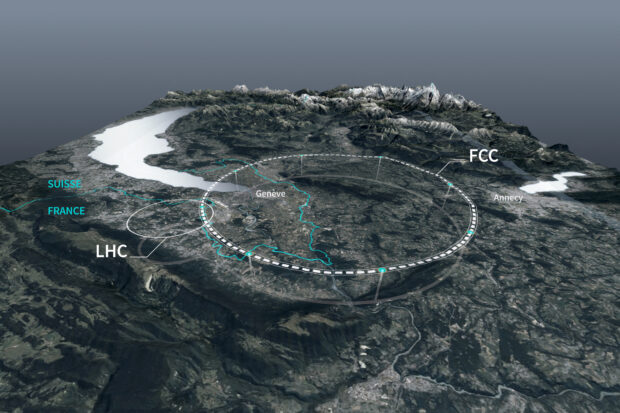Scientists advance plans for giant new atom-smasher by 2040

A handout made available by the European Organization for Nuclear Research (CERN) on April 19, 2023, shows the tunnels of the Future Circular Collider (FCC) and the current Large Hadron Collider (LHC) in Geneva. Environment, seismology, geology, and the CERN are launching their first field analysis to build a particle accelerator three times longer than the current Large Hadron Collider (LHC), which will cease to be used around 2040. AFP
GENEVA — Scientists at the world’s largest atom smasher expressed confidence Monday about moving forward with a multibillion-euro project to build a larger and more powerful particle collider that could help unlock more mysteries of the universe.
Leaders of the European Organization for Nuclear Research, or CERN, said planning is on track for its envisioned Future Circular Collider, which is estimated to cost 15 billion Swiss francs (about 16 billion euros or $17.2 billion) and is hoped to start operating in a first phase by 2040.
But nothing is certain yet, aside from the interest from mostly European and Western countries that bankroll CERN, which is home to the Large Hadron Collider. That project is perhaps best known for helping confirm the subatomic Higgs boson in 2012 after a decades-long quest for what was described as “the missing cornerstone of physics.”
READ: CERN discovers 2 new subatomic particles
“The Future Circular Collider is a possible facility. I’m saying ‘possible’ because we are today at the level of feasibility study. It’s not yet an approved project,” said Fabiola Gianotti, the CERN director-general. She said review committees had not turned up any “technical show-stoppers” for the project so far.
She touted the proposed collider as “a wonderful instrument to improve our understanding of fundamental physics” and a driver of innovation in areas like cryogenics, superconducting magnets, vacuum technologies, and detector-instrumentation technologies that could offer socioeconomic benefits for society.
Article continues after this advertisementHowever, the science that the future collider could generate remains largely unknown. “It’s true that at the moment, we do not have a clear theoretical guidance on what we should look for,” Gianotti said.
Article continues after this advertisementREAD: CERN: Test results show more detail about ‘God particle’
The laboratory that already houses what CERN leaders call the world’s biggest machine uses a network of magnets to accelerate particles through a 27-kilometer (17-mile) underground loop along the French-Swiss border and slam them together, capturing and interpreting the results of the collisions to help explain how fundamental physics works.
Monday’s briefing on the new collider included some proposed changes to the original plan announced in 2019. Among them: The loop will be 91 kilometers instead of the 100-kilometer circuit first envisioned.
But they still aim to boost energy levels of the particle collisions to 100 TeV, or 100 trillion electron volts, about eight times more powerful than the Large Hadron Collider’s 13TeV.